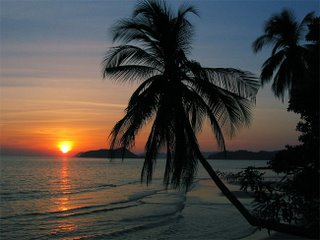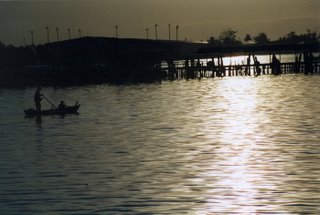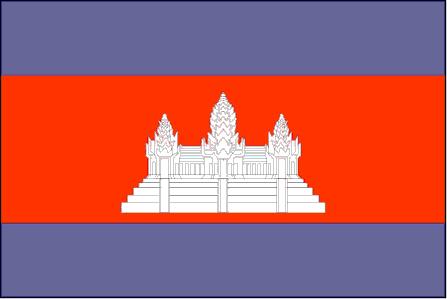CAMBODIA

Cambodia is a country in Southeast Asia. Most Cambodians live on the fertile plains created by the floodwaters of the Mekong River, or near the Tonle Sap (Great Lake) and Tonle Sap River northwest of Phnom Penh. Phnom Penh is Cambodia's capital.
Fact File
Land Area: 181,035 square kilometers. It is bordered to the North by Thailand and Laos; to the East and the South by Vietnam; and to the South and the West by the Gulf of Siam, and Thailand.
Population: Total population is approximately 11,437,656 million (1998). Cambodia comprises a variety of people who are commonly given the name Khmer. Khmer people account for about 90% of citizens, 10% various ethnic background-Chinese, Vietnamese, Chams(Khmer Muslims) and Hilltribes(Khmer Loeu).
Capital: Phnom Penh, 41 square kilometers, is considered as the centre of Industry, Administration, Commerce, and Tourism. The Population is around 1 million.

Climate: Cambodia is situated within a tropical zone, where the average temperature is 27 ºC, average minimum 16 ºC. There are two seasons- the monsoon season and dry season. The humid, rainy season lasts from April to Octobor due to Southwestern monsoons with temperature ranging from 27-35 ºC. The cool, dry season lasts from November to March with temperature ranging from 17-27 ºC.December to January is the coolest period.
Religion: The official religion is Theravada Buddhism. Ninety percent of Khmers are of this religion. The country also has minority religions such as Muslims, Christians.

Language: The official language is Khmer. It is part of the Mon-khmer family. English has gained its popularity these days.
Local Time: 7 hours ahead of GMT (Greenwich Mean Time)
Currency: Riel
PHNOM PENH
PHNOM PENH
The capital of the Kingdom of Cambodia, Phnom Penh, is located at the confluence of three rivers - the Mekong, the Bassac and Tonle Sap. The city is divided into three sections - the north, an attractive residential area; the south or the French part of the city with its ministries, banks and colonial houses; and the centre or the heart with its narrow lanes, markets, foods stalls and shops.Phnom Penh means Hill(Phnom) of lady Penh, who found it in 1372.The first establishment did not last long; the capital moved from one place to another. The capital Phnom Penh was sixth after Nokor Phnom, Angkor Wat, Longvek, Srey Sonthor, and Oudong. At the end of 19th century, the capital moved to Phnom Penh again and still remain the same up to the present time.Covers an area of 41 square Kilometres, Phnom Penh is a major political, economic, cultural, communication, and tourism centre for home and world service.

ROYAL PALACE Royal Palace was built in 1866 by King Norodom; the Royal Palace is now home to the king of Cambodia. The palace is actually a number of structure within a pagoda-style compound. An awe-inspiring sight, the throne room, or the main building has a tiered roof topped by 59m tower.
 INDEPENDENCE MONUMENT:
INDEPENDENCE MONUMENT:
The monument was built in 1958 to symbolise the independence that Cambodia gained from France in 1953. The French fully abandonned their interests in Indochina following defeat by the Vietnamese at the battle of Dien Bien Phu in May 1954. Independence is marked in Cambodia on the 9th November. The monument has a unique and peculiar style and doubles as a memorial to Cambodian.
 NATIONAL MUSEUM
NATIONAL MUSEUM
The NATIONAL MUSEUM of Cambodia is housed in a graceful terracotta structure of traditional design (built 1917-20) just north of the Royal Palace. It is open Tuesday to Sunday from 8 to 11 am and from 2 to 5 pm;photography is prohibited inside. The School of Fine Arts has its headquarters in a structure behind the main building.


 WAT PHNOM
WAT PHNOM
You may also want to check out WAT PHNOM which sits on a tree covered hill about 30m high in the northeast of the city. It is said that the first pagoda was built in 1373 to house four statues of the Buddha deposited here by the Mekong river. It was discovered by a woman named Penh. Thus, the name Phnom Penh, the hill of Penh.
The people believe that this temple is powerful in that anyone who makes a wish will have it granted.
It is not surprising to see many people coming here to pray for protection or healing. Many bring lotus flowers as offerings for prayers answered. At the bottom of the hill is a small zoo, but its most endearing residents, the monkeys, live free in the trees.

CENTRAL MARKET
A visit to the markets and market halls is a must as they give an opportunity to be acquainted with the country's local products and also to buy textiles, antiques, gold and silver jewellery.
The four wings of the yellow coloured Central Market are teeming with numerous stalls selling gold and silver jewellery, antique coins, clothing, clocks, flowers, food, fabrics, shoes and luggage.
KIRIROM NATIONAL RESORT
 KIRIROM NATIONAL RESORT
KIRIROM NATIONAL RESORT
Located at Phnom Sruoch district in the province of Kampong Speu, Kirirom National Park is established on a seven hundred meters hill covering an area of over thirty five thousand hectares in the Elephant Mountains. The name 'Kirirom' meaning Mountain of Joy was given to it by the King of Cambodia. Kirirom National Park, a high altitude plateau, is known for its unique high elevation pine forest, which forms the headwaters for numerous streams feeding Kampong Speu Town.
This park is part of the 'Southwest Cluster Protected Areas' which include Phnom Bokor, Preah Sihanouk and Kep National Parks. Attractions at this hill station of Kirirom are its spectacular scenery and its astonishing waterfalls. This park is also the home to many endangered species of animals such as pleated gibbon, sun bear and tiger . You can take a ride in the traditional ox-cart ride or trek along the walking trails among the pine trees. This natural resort is located one hundred and twenty kilometers to the west of Phnom Penh.
The Kirirom National Park, whose official name is Preah Suramarith Kossmak, is about 80,000 acres of forested land on a rare plateau in southwestern Cambodia. The elevation is about 2,200 feet, high enough to support a large pine forest quite distinct from most of the country's tropical jungle.
TONLE SAP LAKE

Tonle Sap lake is located in the middle of the country, Cambodia's Greatest Lake, is one of the most unique geographical wonders of the world. The extraordinary biodiversity and hydrology of the Tonle Sap Lake and the Tonle Sap River make it a remarkable ecological wonder of the world.
The Tonle Sap 160 km in length, and 36km in width. During the dry season, the Tonle Sap has a size of 3000 sq-km with a depth of 1 m. During the wet season, it has a size of 10000 sq-km with a depth of 12 m. The Tonle Sap has abundant supplies of fresh water fish.
For centuries the Great Lake people have been able to catch 10 tons of fish per square kilometre and provide the major source of Khmer sustenance. Moreover, for astute bird-watcher, the aquatic habitat attracts thousands of birds and fish-eating waterfowl which flock to the wetlands before the rain begins in June.
Species inhabiting the Lake include carp, catfish, mussel, herring, climbing perch and gourami.
On the banks of the mighty Great Lake and Mekong River, people have celebrated for over two hundred years the changing of Rivers flow. During the rainy season, the Tonle Sap river reverses its direction, flooding the lake, increasing its size almos tenfold, making it the largest freshwater body in Southeast Asia.
During the flood season, water engulfs the surrounding forest, regulating agricultural production by ensuring that the countryside is covered with fresh, fertile silt for rice cultivation.

SIEM REAP

 Siem Reap, is a province located in northwestern Cambodia, on the shores of the Tonle Sap lake. The provincial capital is Siem Reap. The name literally means Siamese defeated referring to the victory of the Khmer Empire over the army of the Thai kingdom of Ayutthaya in the 17th Century.
Siem Reap, is a province located in northwestern Cambodia, on the shores of the Tonle Sap lake. The provincial capital is Siem Reap. The name literally means Siamese defeated referring to the victory of the Khmer Empire over the army of the Thai kingdom of Ayutthaya in the 17th Century.
Located in northwest Cambodia, Siem Reap is the major tourist hub in Cambodia, as it is the closest city to the temples of Angkor. The most recognizable of the temples, Angkor Wat, literally Capital Temple, built by King Suryavarman II the early 12th century provides the largest tourist draw. Recently the city has seen a great deal of expansion, hundreds of hotels, restaurants and shops, catering to both international and Cambodian tourists have opened to serve the influx of visitors.
 Other sites of interest near Siem Reap include Angkor Thom built by Jayavarman VII, Banteay Srei, Ta Prohm, as well as hundreds of other temple ruins. Angkor, and the surrounding area that would later become known as Siem Reap, faced repeated invasions from the Thais, and ceased to be the capital after a seven-month siege in 1431. The capital was moved to Phnom Penh in 1432, and then to Lovek and Oudong, before moving back to Phnom Penh in 1866.
Other sites of interest near Siem Reap include Angkor Thom built by Jayavarman VII, Banteay Srei, Ta Prohm, as well as hundreds of other temple ruins. Angkor, and the surrounding area that would later become known as Siem Reap, faced repeated invasions from the Thais, and ceased to be the capital after a seven-month siege in 1431. The capital was moved to Phnom Penh in 1432, and then to Lovek and Oudong, before moving back to Phnom Penh in 1866.
The province is subdivided into 12 districts: Angkor Chum, Angkor Thum, Banteay srei, Chi Kraeng, Kralanh, Puok, Prasat Bakong, Siem Reab, Soutr Nikom, Srei Snam, Svay Leu, and Varin.

ANGKOR WAT Angkor Wat, World heritage, was built by King Suryavarman II in the XIIth Century and was dedicated to Brahmanism. Angkor Wat is 6 Km from Siem Riep town and covers an area of 200 hectares.



SIHANOUK VILLE
 SIHANOUKVILLE - Beach Resort
SIHANOUKVILLE - Beach Resort
'Beach town', 'port community', 'fledgling resort destination' - all describe Sihanoukville, Cambodia's premier beach town. Sihanoukville's white sand beaches and warm Gulf of Thailand waters combine with a laid back, beachy atmosphere to provide a great little tropical getaway. Sihanoukville is a place to unwind by the beach, enjoy the fresh from-the-ocean seafood, take in a snorkeling or scuba trip, and generally slow-down, lay back and chill-out. Sihanoukville has a different look and feel than most Cambodian towns. Constructed as a port city in the late 1950s, the town is much newer, more urban and cosmopolitan than most Cambodian provincial cities. Nowadays, Sihanoukville is as much a beach town as it is a port town, catering to beach-going weekenders from Phnom Penh as well as a steadily increasing number of foreign visitors. Still, the pace of life in Sihanoukville is very relaxed. Cows occasionally wander the main road, outside town foreign faces draw smiles and curious stares, and most of the beaches offer only beach umbrellas, thatched roofed eateries, and a growing number of restaurants, bungalows and hotels.
Sihanoukville has a more than ample supply of accommodations, including a 5-star resort complex on Sokha Beach, several mid-range places downtown and at the beaches, a few 'upscale' three-star hotels, and dozens of budget guesthouses, especially on Weather Station Hill (Victory Hill). Considering the moderate number of visitors to Sihanoukville, the town offers a surprising number and variety of restaurants and bars. Fresh seafood, especially crab, prawns and ocean fish, has always been one of the town's biggest draws, but there is also a wide variety of places offering foreign cuisines - Australian, French, Indian, German, Sri Lankan, British, Italian, pizza places, a couple of western bakeries and even a espresso coffee shop. And these days Sihanoukville offers a pretty good night life as well with a wide variety of bars staying open well into the wee hours, especially on Weather Station Hill, in the downtown area, and the beach bars on Ochheuteal, ‘Serendipity’ and Victory Beaches.
Sihanoukville, also known as Kampong Som, or Kampong Saom, is a port city in southern Cambodia on the Gulf of Thailand. The city is the only deep water port in Cambodia and its beaches are rapidly making it popular as a tourist destination.
 Sihanoukville is surrounded by palm-fringed sandy beaches and pristine tropical islands off its south and west coast. Beaches here lies on the west contour of the city, from north to south, namely Victory Beach, Lamherkay Beach, Koh Pos Beach, Independence Beach, Sokha beach, Serendipity Beach and Occheuteal Beach. The most popular beaches are Occheuteal, Sokha, Independence and Victory. Tourist are allowed island hopping, diving, snorkeling and game fishing at the islands nearby.
Sihanoukville is surrounded by palm-fringed sandy beaches and pristine tropical islands off its south and west coast. Beaches here lies on the west contour of the city, from north to south, namely Victory Beach, Lamherkay Beach, Koh Pos Beach, Independence Beach, Sokha beach, Serendipity Beach and Occheuteal Beach. The most popular beaches are Occheuteal, Sokha, Independence and Victory. Tourist are allowed island hopping, diving, snorkeling and game fishing at the islands nearby.
Sokha Beach Sokha Beach is located just west of Serendipity Beach . This beach is privately owned and is the first luxury beach hotel in Cambodia. It provides many facilities with a wide white sandy beach; if you are not staying at the hotel the guards may or may not stop you from going on to the beach.
Independence Beach Independence Beach is located next to Sokha Beach on its west. The beach was named after the old Independence Hotel. This beach offers a good stretch of clean sand.
Situated at the northern end of the beach is Independence Hotel and Koh Pos Beach, the nice tiny island only 800m off the coast. Koh Pos offers cool shades but rocky waters.
Victory Beach Victory beach is situated at the furthest north of the peninsula of Sihanoukville. It was the original backpacker beach and still popular with budget travelers. At the northern end of the beach is located the deep sea port. Thus, apart from white sand and blue sea, this beach offers a good spot to enjoy the scenes of sunset. At the further south of Victory Beach is another small strand of sand called Lamherkey Beach where the Hawaii Seaview Restaurant is located. It is the place where a French/ Cambodian construction team laid groundwork for the construction of the new Port of Kampong Som during 1950s. At this beach, you can hire a boat to nearby islands.
Islands
There are more than a dozen islands off the coast of Sihanoukville for tourists to hop around. Most of them are yet to be developed for an overnight stay with the exception of Bamboo Island, which is also called Koh Russei. Many guesthouses, restaurants and cafes on Ochteal Teal Serendipity beach offer trips and packages to these islands.Soon Nail Island (also called Magic Island because it looks like a mushroom) will have a hotel run by the folks from the snake house. They already have a pier and most of the hotel and restaurant are finished.
Koh Rong Koh Rong is situated west of the Sihanoukville coast. It offers the fantastic strand of beach on its southwest, stretching about 5 km. It has fresh water resources on the island and a bustling fishing community on the southeast with basic supplies including fresh water, fish and crab.
Koh Rong Samlon Koh Rong Samlon is a bit smaller than Koh Rong and situated on its south. Beautiful beaches are on the east coast, where a large heart-shaped bay with some shellfish cultivation is located, and on the north shoreline facing Koh Rong.
Koh Tang Koh Tang is located quite far from the main shoreline of Sihanoukville. Going there needs trippers to stay overnight on board. It offers interesting diving spots most of which are not frequently explored. The island is home to a military outpost and travelers should expect to be boarded by military personnel when out at the island.



























